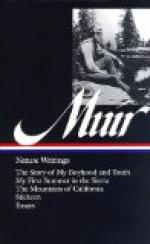One day when father happened to have a little leisure, he said, “Noo, bairns, rin doon the meadow and get your powny and learn to ride him.” So we led him out to a smooth place near an Indian mound back of the shanty, where father directed us to begin. I mounted for the first memorable lesson, crossed the mound, and set out at a slow walk along the wagon-track made in hauling lumber; then father shouted: “Whup him up, John, whup him up! Make him gallop; gallopin’ is easier and better than walkin’ or trottin’.” Jack was willing, and away he sped at a good fast gallop. I managed to keep my balance fairly well by holding fast to the mane, but could not keep from bumping up and down, for I was plump and elastic and so was Jack; therefore about half of the time I was in the air.
After a quarter of a mile or so of this curious transportation, I cried, “Whoa, Jack!” The wonderful creature seemed to understand Scotch, for he stopped so suddenly I flew over his head, but he stood perfectly still as if that flying method of dismounting were the regular way. Jumping on again, I bumped and bobbed back along the grassy, flowery track, over the Indian mound, cried, “Whoa, Jack!” flew over his head, and alighted in father’s arms as gracefully as if it were all intended for circus work.
After going over the course five or six times in the same free, picturesque style, I gave place to brother David, whose performances were much like my own. In a few weeks, however, or a month, we were taking adventurous rides more than a mile long out to a big meadow frequented by sandhill cranes, and returning safely with wonderful stories of the great long-legged birds we had seen, and how on the whole journey away and back we had fallen off only five or six times. Gradually we learned to gallop through the woods without roads of any sort, bareback and without rope or bridle, guiding only by leaning from side to side or by slight knee pressure. In this free way we used to amuse ourselves, riding at full speed across a big “kettle” that was on our farm, without holding on by either mane or tail.
These so-called “kettles” were formed by the melting of large detached blocks of ice that had been buried in moraine material thousands of years ago when the ice-sheet that covered all this region was receding. As the buried ice melted, of course the moraine material above and about it fell in, forming hopper-shaped hollows, while the grass growing on their sides and around them prevented the rain and wind from filling them up. The one we performed in was perhaps seventy or eighty feet wide and twenty or thirty feet deep; and without a saddle or hold of any kind it was not easy to keep from slipping over Jack’s head in diving into it, or over his tail climbing out. This was fine sport on the long summer Sundays when we were able to steal away before meeting-time without being seen. We got very warm and red at it, and oftentimes poor Jack, dripping with sweat like his riders, seemed to have been boiled in that kettle.




